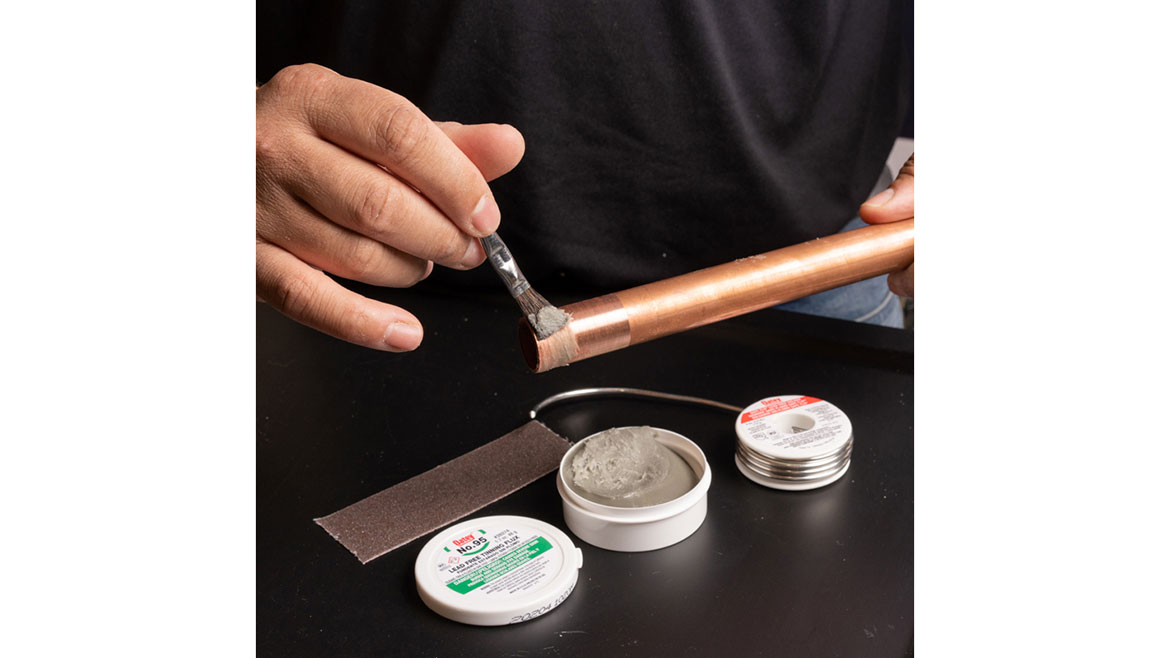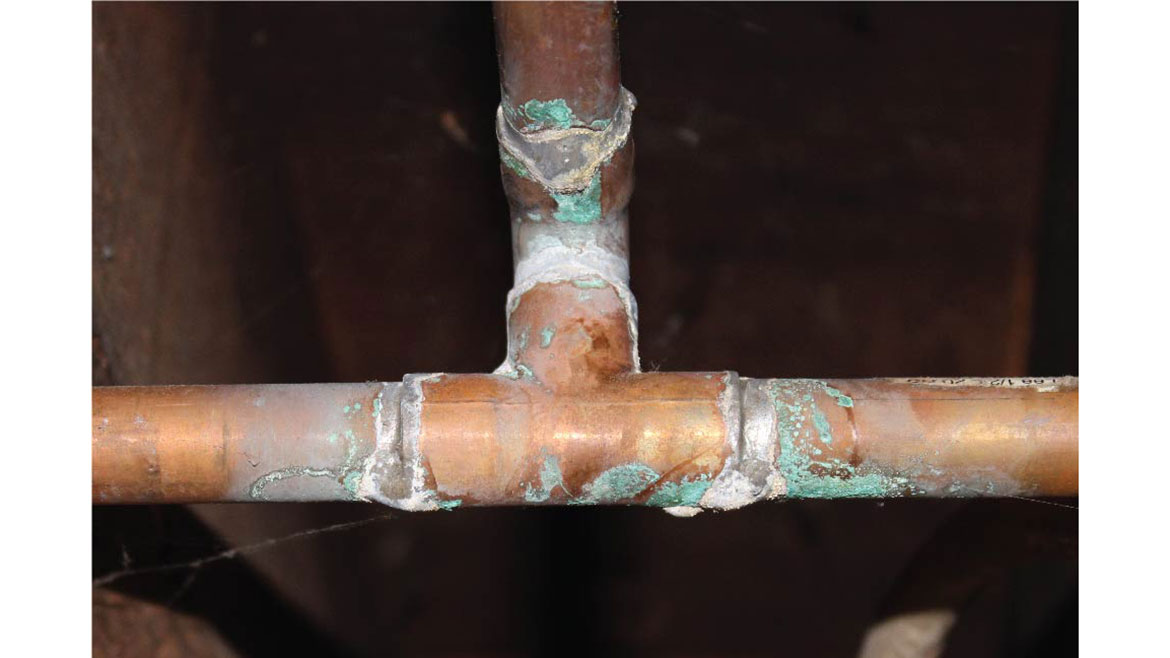Mastering low-lead brass soldering with tinning flux
Best practices when using tinning flux.

Flux is a critical component in ensuring the integrity of solder joints. Acting as both a cleaning and wetting agent, flux prepares the surfaces to be joined and aids in the flow of solder, eliminating oxidation — a common barrier to achieving a solid, leak-free connection. Images courtesy of Oatey Co.
Tinning Flux is particularly useful to solder low- or no-lead brass effectively. Generally, lead brass conducts heat better than metals used today. However, most older, lead-piping systems have been eliminated because research has shown that lead in water pipes can harm the human body through repeated exposure. The Environmental Protection Agency determined that drinking water's maximum lead-contaminant level should be zero due to its toxicity.
Soldering low lead brass can be daunting since it doesn't conduct heat well. Using tinning flux will help eliminate the human error of soldering low-lead brass and help fill the joint to create a leak-free connection.
Let's explore how tinning flux helps the soldering process, how to apply it, and the types of tinning flux available at your supply house or local hardware store.
Understanding tinning flux in soldering
Flux is a critical component in ensuring the integrity of solder joints. Acting as both a cleaning and wetting agent, flux prepares the surfaces to be joined and aids in the flow of solder, eliminating oxidation — a common barrier to achieving a solid, leak-free connection. Think of it as applying a primer before painting: it ensures your end product is robust and complete.

Soldering low lead brass can be daunting since it doesn't conduct heat well. Using tinning flux will help eliminate the human error of soldering low-lead brass and help fill the joint to create a leak-free connection.
Soldering low lead brass can be daunting since it doesn't conduct heat well. Using tinning flux will help eliminate the human error of soldering low-lead brass and help fill the joint to create a leak-free connection.
Tinning flux stands out from other flux formulas by containing ground-up solder flakes, known as tinning powder. These particles clean, tin and flux commonly soldered metals, including copper, brass, zinc, galvanized iron, lead and tin or copper-coated metals. The tinning powder enhances the flux formula, pre-tinning piping and improving solder flow, which is particularly beneficial when soldering larger diameter piping systems.
Selecting the proper flux is crucial for the smoothness and strength of your solder joints. The wrong flux can lead to issues such as incomplete filling, discoloration or flux entrapment, all of which can deteriorate the joint over time. With a quality flux, these risks are mitigated, ensuring a professional finish.
Tinning flux, containing a small amount of solder powder, not only cleans the pipe but also pre-tins the fitting. This can be especially helpful for beginners or those working quickly, as it simplifies the process by combining two steps into one, promoting better adhesion and quicker filling of the joint. Tinning flux helps eliminate small mistakes and acts as insurance against improper soldering.
While tinning flux is advantageous for efficiency and ease, particularly in smaller or less complex jobs, regular flux offers experienced plumbers greater control over the amount and placement of solder. Both types of flux play pivotal roles in creating strong, durable joints, but the choice between them should be guided by the specific needs of the project and the skill level of the individual performing the work.
Note: Tinning flux is not meant for use with aluminum, stainless steel or magnesium. It should not be used on electrical parts. Aluminum conducts heat so well that it is difficult to keep it warm enough to solder, while stainless steel should be brazed or welded. Consult Oatey Technical Department for applications not specifically referenced here.

Selecting the proper flux is crucial for the smoothness and strength of your solder joints. The wrong flux can lead to issues such as incomplete filling, discoloration or flux entrapment, all of which can deteriorate the joint over time. With a quality flux, these risks are mitigated, ensuring a professional finish.
Selecting the proper flux is crucial for the smoothness and strength of your solder joints. The wrong flux can lead to issues such as incomplete filling, discoloration or flux entrapment, all of which can deteriorate the joint over time. With a quality flux, these risks are mitigated, ensuring a professional finish.
Best practices when using tinning flux during the soldering process
Preparation: Thoroughly cleaning all surfaces before soldering is essential. Use a deburring tool to remove sharp edges, small bumps and roughness from the inside of the pipe ends. This creates a smooth surface and reduces resistance to water flow. For larger-diameter pipes, use a fitting brush or an abrasive sand cloth to clean the fitting hub and the pipe. Proper preparation removes contaminants that could interfere with the soldering process, ensuring a clean and effective joint.
Applying tinning flux: Applying tinning flux correctly is critical for a successful soldering job. Use an acid brush to apply a thin layer of flux inside the fitting and on the outside of the pipe. Avoid using your fingers and wash your hands thoroughly after use. Excess flux should be removed with a damp cloth before connecting the pieces. Be mindful that flux is acidic and can etch the pipe if left on for too long without soldering, so only flux pipes that will be soldered within four hours.
Heating the pipe: Properly heating the pipe is vital to achieving a strong joint. For small-diameter piping, direct the heat near the joint. For larger diameter piping, move the heat around the joint to ensure adequate solder flow. Begin by heating the pipe just outside of the hub or directly at the joint until the flux starts to bubble. Then, apply heat to the base of the fitting. This method ensures that the solder follows the flux towards the heat, filling the entire fitting. Remove the flame as soon as the solder melts to prevent excess solder flow or burning off the flux, which can lead to leaks.
Removing excess flux: Wiping away any residual flux or solder drips immediately after soldering, while the joint is still warm, is an important step that should not be overlooked. Failure to remove excess flux can result in severe pipe damage over time. Residual flux can cause corrosion and the formation of Verdigris, a greenish-blue discoloration that damages copper, bronze, and brass. This can eventually lead to pitting and leaks, even if it takes many years to manifest.
By adhering to these best practices, you can ensure that your soldering work with low-lead brass is reliable and long-lasting.

Applying tinning flux correctly is critical for a successful soldering job. Use an acid brush to apply a thin layer of flux inside the fitting and on the outside of the pipe. Avoid using your fingers and wash your hands thoroughly after use. Excess flux should be removed with a damp cloth before connecting the pieces.
Applying tinning flux correctly is critical for a successful soldering job. Use an acid brush to apply a thin layer of flux inside the fitting and on the outside of the pipe. Avoid using your fingers and wash your hands thoroughly after use. Excess flux should be removed with a damp cloth before connecting the pieces.
Types of tinning flux
Water-soluble tinning flux is water-flushable flux containing solder powder to aid in the soldering process. It is good for large-diameter copper piping and will not turn copper piping green.
Water-soluble tinning flux will flush out of the line when running normal water and is compatible with all common plumbing solder alloys. Water-soluble flux is less corrosive and self-cleans on the pipe's interior as water flows through the lines. It has a narrower temperature range when heating, but it works with all common plumbing solder alloys.
Petrolatum-based tinning flux (non-soluble flux) also contains tinning powder to help pre-tin the pipe to provide superior wetting properties for better solder flow. It cleans, tins and fluxes most commonly soldered metals, such as copper, copper-coated metals, brass, zinc, galvanized iron, lead and tin. With a petrolatum-based tinning flux, it's required to flush the line with a trisodium phosphate solution, due to their water insolubility.
Fluxing is a critical step in the soldering process. Using tinning flux is particularly helpful when you are soldering larger-diameter pipes, because it acts as a primer and helps fill pipe joints completely.
Tinning flux is also helpful for tradesmen who haven't done a lot of soldering, as it provides added protection to the pipe joint.
Looking for a reprint of this article?
From high-res PDFs to custom plaques, order your copy today!










